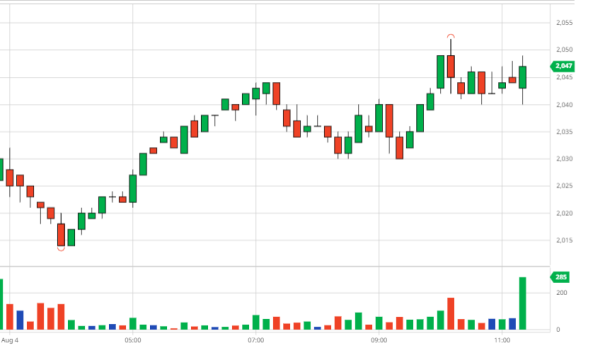The price of coffee on two futures floors increased sharply when there was more basic information to support in the short and medium term…

Robusta chart London September 2022 session on 04/08/2022
At the end of the session, the price of Robusta coffee on the ICE Europe – London exchange returned to the upside. The September spot term increased by 19 USD, to 2,045 USD/ton and the November delivery term increased by 18 USD, to 2,041 USD/ton, very significant increases. Trading volume remain above average.
Similarly, the price of Arabica coffee on the ICE US floor – New York has the same upward trend. September spot futures added 4.65 cents to 219.30 cents/lb and December futures added 4.50 cents to 215.75 cents/lb, strong gains. Trading volume remained very high above average.
The price of green coffee beans in the Central Highlands provinces increased by 400-500 dong, up to range from 41,000 to 41,600 dong/kg.
Coffee futures prices continued the upward momentum on both exchanges after correcting at the beginning of the session on concerns that the European Central Bank (ECB) would raise the basic interest rate for the euro by 0.5% after 11 years of no interest. and inflation in the Eurozone stood at 8.7%, the highest in the world.
According to observers, after the market pushed US and EU treasury bond yields sky-high with the visit to Taiwan of the US House of Representatives Speaker, but eased soon after, the Group of Producers OPEC+ oil producer decided to increase production by 100,000 barrels per day, causing crude oil prices to plummet below 100 USD/barrel, causing speculation to shift capital flows to other derivatives, helping coffee prices to benefit.
Besides USDX falling back in a basket of strong currencies helping emerging currencies regain value, USD exchange rate fell by 1.02% to 1 USD = 5,2220 R$, there is also the impact of Copom – Brazil raised the interest rate on the Reais by 0.5%, to 13.75%/year, causing Brazilians to reduce the sale of new crop export coffee, which supported the price of coffee to rise on both exchanges.
In addition, the news that FNC – Colombia’s Arabica coffee production and exports in July dropped sharply by approximately 20%, supported the market to increase buying due to short-term supply concerns, combined with the ICE inventory report both This week fell to a 23-year low with no additions seen.
English (giacaphe.com)
